Do you have a question about the DeLonghi ESPRESSO COFFEE and is the answer not in the manual?
Covers avoiding burns, hot surfaces, wet hands, and general caution during operation.
Includes checking for damage, keeping packaging from children, domestic use, and turning off when not in use.
Focuses on supervision for children and infirm persons and preventing them from playing with the appliance.
Addresses breakdown, not touching, contacting authorized service centers, and cable replacement.
Covers placing on a flat surface, voltage, and proper earthing for safe operation.
Details handling plug incompatibility and replacing damaged power cables by professionals.
Advises on avoiding freezing temperatures and storing excess power cable neatly.
Instructions on removing, filling, and replacing the water tank correctly.
Steps to preheat the machine for optimal espresso temperature.
Detailed guide on filling, tamping, attaching, and brewing espresso with ground coffee.
Essential steps for the first use, including cleaning accessories and initial brewing cycles.
Guidance on using ESE standard pods, including insertion and positioning.
Recommends greasing lateral tabs for effective closure and avoiding leaks.
Steps for brewing coffee using the filter holder for pods, similar to ground coffee.
Instructions on how to safely remove the used coffee pod.
Instructions to prepare espresso coffee cups as the base for cappuccinos.
Detailed steps on frothing milk using the steam nozzle, including temperature and volume.
Essential post-use cleaning procedure for the milk frother and steam nozzle.
Steps to dispense hot water from the cappuccino maker nozzle.
Procedure for cleaning the filter holder and its components after approximately 300 coffees.
Instructions for cleaning the filter holder designed for coffee pods.
Routine cleaning of the espresso boiler outlet, recommended at least twice a year.
Guidelines for using soft cloths, cleaning drip-trays, and avoiding immersion in water.
Advises descaling every 300 cups of coffee using specific products or citric acid.
Detailed instructions for descaling using water and citric acid, including solution circulation.
States that repairs due to calcium build-up are not covered if descaling is not performed regularly.
Addresses problems like lack of water, blocked outlets, or improperly inserted components.
Covers dripping, cold coffee, light or dark cream, and acidic taste related to preparation.
Diagnoses noisy pumps, issues with milk not frothing, or dirty frothing components.
Covers avoiding burns, hot surfaces, wet hands, and general caution during operation.
Includes checking for damage, keeping packaging from children, domestic use, and turning off when not in use.
Focuses on supervision for children and infirm persons and preventing them from playing with the appliance.
Addresses breakdown, not touching, contacting authorized service centers, and cable replacement.
Covers placing on a flat surface, voltage, and proper earthing for safe operation.
Details handling plug incompatibility and replacing damaged power cables by professionals.
Advises on avoiding freezing temperatures and storing excess power cable neatly.
Instructions on removing, filling, and replacing the water tank correctly.
Steps to preheat the machine for optimal espresso temperature.
Detailed guide on filling, tamping, attaching, and brewing espresso with ground coffee.
Essential steps for the first use, including cleaning accessories and initial brewing cycles.
Guidance on using ESE standard pods, including insertion and positioning.
Recommends greasing lateral tabs for effective closure and avoiding leaks.
Steps for brewing coffee using the filter holder for pods, similar to ground coffee.
Instructions on how to safely remove the used coffee pod.
Instructions to prepare espresso coffee cups as the base for cappuccinos.
Detailed steps on frothing milk using the steam nozzle, including temperature and volume.
Essential post-use cleaning procedure for the milk frother and steam nozzle.
Steps to dispense hot water from the cappuccino maker nozzle.
Procedure for cleaning the filter holder and its components after approximately 300 coffees.
Instructions for cleaning the filter holder designed for coffee pods.
Routine cleaning of the espresso boiler outlet, recommended at least twice a year.
Guidelines for using soft cloths, cleaning drip-trays, and avoiding immersion in water.
Advises descaling every 300 cups of coffee using specific products or citric acid.
Detailed instructions for descaling using water and citric acid, including solution circulation.
States that repairs due to calcium build-up are not covered if descaling is not performed regularly.
Addresses problems like lack of water, blocked outlets, or improperly inserted components.
Covers dripping, cold coffee, light or dark cream, and acidic taste related to preparation.
Diagnoses noisy pumps, issues with milk not frothing, or dirty frothing components.
| Brand | DeLonghi |
|---|---|
| Model | ESPRESSO COFFEE |
| Category | Coffee Maker |
| Language | English |
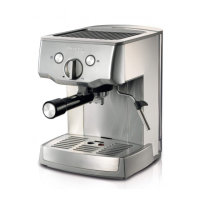
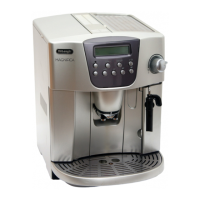




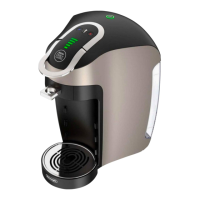
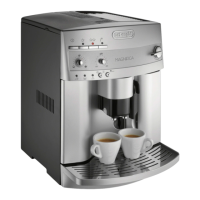
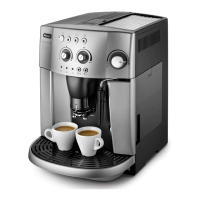
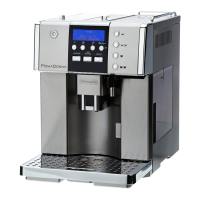
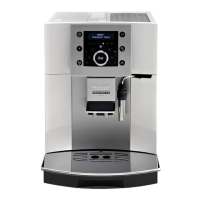
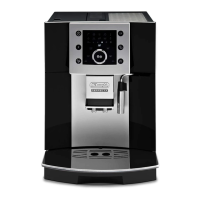
